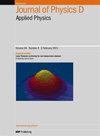Floquet-engineered valley topotronics in Kekulé-Y bond textured graphene superlattice
IF 3.2
3区 物理与天体物理
Q2 PHYSICS, APPLIED
引用次数: 0
Abstract
The exquisite distortion in a Kekulé -Y (Kek-Y) superlattice merges the two inequivalent Dirac cones (from theKekulé-Y 键纹理石墨烯超晶格中的浮凸工程谷拓扑技术
Kekulé -Y(Kek-Y)超晶格中的精致变形将两个不等价的狄拉克锥(来自 K- 点和 K′-点)合并成六边形布里渊区中最高的对称 Γ 点。在这里,我们报告了紫外圆偏振光不仅在Γ点打开了拓扑缺口,而且还解除了该点的谷退性。借助 Floquet 动力学并通过设计一种高频近似方案,我们提出偏振光的左右手性为在 Kek-Y 形石墨烯超晶格中实现谷选择性圆二色性提供了可能性。此外,由于贝里曲率的非消失和枚举的山谷分辨切尔恩数 CK/CK′=+1/-1,我们可以为两个山谷赋予两种伪自旋味道(上/下)。因此,上述观察结果证实了拓扑转变,表明在光子压制的 Kek-Y 中很容易实现谷量子反常霍尔态。这些发现进一步表明,光谷极化不为零,且在Γ点处达到最大。因此,我们的论文提出了一种可光学切换的拓扑山谷滤波器,这正是不断发展的山谷电子学所需要的。
本文章由计算机程序翻译,如有差异,请以英文原文为准。
求助全文
约1分钟内获得全文
求助全文
来源期刊
CiteScore
6.80
自引率
8.80%
发文量
835
审稿时长
2.1 months
期刊介绍:
This journal is concerned with all aspects of applied physics research, from biophysics, magnetism, plasmas and semiconductors to the structure and properties of matter.

 求助内容:
求助内容: 应助结果提醒方式:
应助结果提醒方式:


